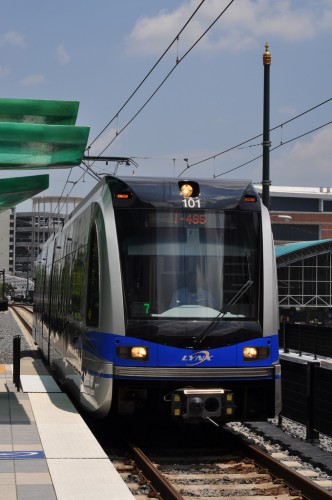
My recent summer vacation took my family to Myrtle Beach, SC. By virtue of good fortune, and a wife who is accepting of my psychotic civic activism, we were able to spend a morning in Charlotte, NC to take a ride on the Lynx light rail line. The Lynx (or Blue Line) is a modern light rail system that opened in 2007 and operates daily on low overheads.
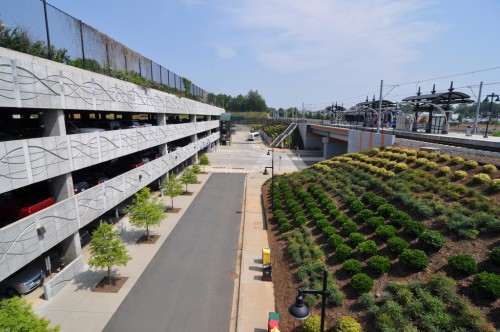
At this point in my advocacy, I consider it a treat to be able to ride a light rail train. So when we arrived, I was very excited to be able to experience the service. I had my camera at the ready! As we were approaching the elevator to get from ground level to the platform level, a train was pulling away. We took the elevator up, crossed a walk and then the tracks to a ticket kiosk. A speaker announced that the next train was set to arrive in 8 minutes. This was nice to hear! We didn’t even have to check a schedule, the next arrival was in a manageable amount of time.

We spent that 8 minutes taking photos of the platform, the adjoining parking structure (which has a playground on the roof). Before we knew it, the train was ready to pull out of the station and we were on board heading for downtown Charlotte. The time was near 11am.
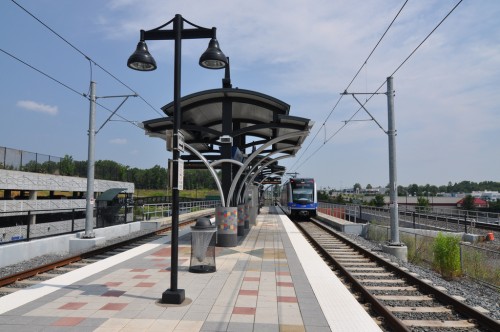
The train was sparsely populated when we left the outermost station, which is on the I-485 beltline. However, two stops in, it was starting to turn into a standing room only environment. The closer we got, the more packed it got. There were people of ALL ethnic backgrounds on the train. A predominantly black population was on board, but many Hispanic and whites were aboard as well. I spoke with one man who asked if I was local and told him I was from Indy. I asked how he liked having the train and he commented about his broken car and how the train is a godsend for him to be able to ride. Another woman commented that she was anxious for the extension of the existing line to the NE side of the region.
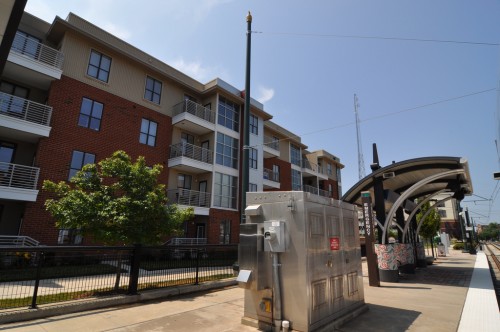
We did not get off on any of the stations along the way but I managed to step out of the train and snap some photos of property surrounding the stations along the way. The outer stations have more park & rides compared to the inner stations. In fact, the two outer stations are solely park & ride. There seemed to be little indication that TOD had taken hold around these stations. However, the closer to downtown the train travelled, the more TOD seemed to be getting a toe hold. Additionally, less parking lots surrounded these stations compared to the outer stations.
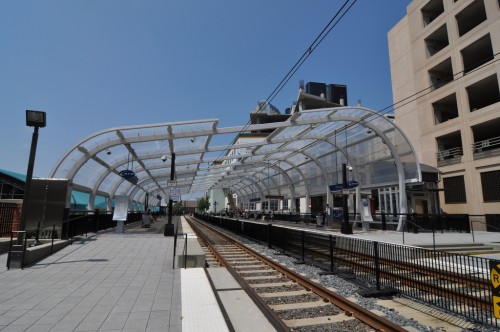
We reached the downtown transit center station which was the next to last station on the line. This station let off in the heart of downtown Charlotte next to where the Bobcats play. In addition to that structure, there is a large bus station at ground level adjacent to the light rail tracks. At this point in time, it would be proper to note that a lot of the trackage in downtown is elevated above ground level thereby eliminating interaction with automobiles. Some of the outer stations are aligned this way too, but not all of them. There are a lot of stretches between stations that run at ground level.
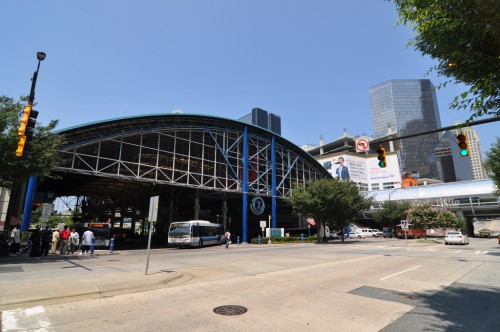
We took a moment to use the restroom inside there. Then, we took a short stroll around downtown and landed on the ground floor of the Wells Fargo tower where a vast food court was located. I had a fantastic veggie burrito at what I think was a local establishment.
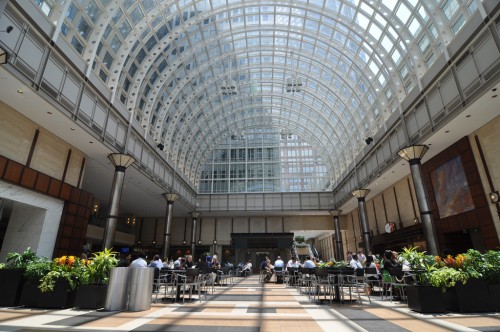
After lunch, we went to the 3rd street station to wait on the next outbound train. We waited about 5 minutes on the next train to arrive and when it did, we boarded to head back out to the 485 park & ride. The train was PACKED as we stepped on.
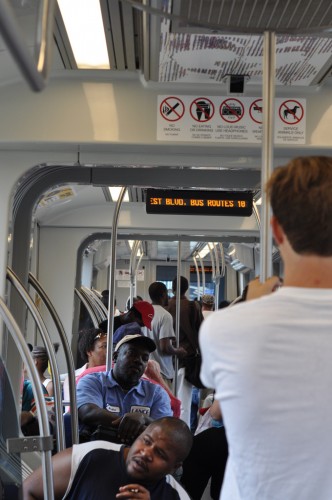
We had to park the stroller my son was in and hold him. I stood and my wife sat with him. This was around 1:30pm and I was pleasantly surprised to see the train so packed. The further we got out towards the 485 station, the more people got off.
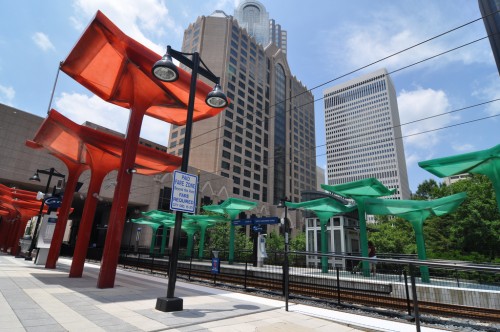
When we de-boarded the train, the sun was shining and we were able to return to our car which had not been vandalized or otherwise messed with which was nice to see. Being in an unfamiliar location, one never knows what to expect. We took a ride up the road adjacent to the line, South Blvd. In this area, the road and adjacent properties reminded me of N Keystone Avenue here in Indy from say, 38th to 62nd. Wide, ugly and lots of auto oriented development. It may be this type of environment that has been the hardest to influence by the light rail route.
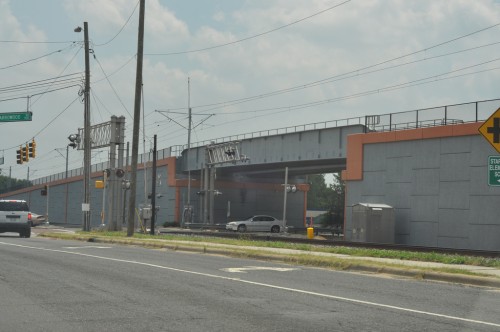
In hindsight, it would have been nice to spend more time investigating other stations to get a feel for how the TOD has developed around some of the stations. I blogged about the Lynx line last year over at my personal blog based off of web-based research. It would have been nice to be able to walk around the developments, but my vacation was more important and we were over 3 hours from the beach. I was looking forward to unplugging from my day job and the blog at that point so we decided to make our way to the coast. I consider the experience of riding the Lynx to have been a beneficial one if for nothing else, the experience. It was rapid. There were short overheads. The trains were cool and comfortable and the transit advocate in me continues to want to smack the ignorant who say that light rail doesn’t work and we don’t need it.
Thanks for your observations of the Lynx Blue Line! I enjoyed seeing the photos and how the city changed as you moved closer to downtown. It will be interesting to see how Charlotte develops over time along this line.
Yeah, it was quite an eye opener to see how much TOD has aligned itself around the stops closer to downtown. I think of the 15 stations, 7 of them have park and rides. So there is a lot of opportunity to fail here. They have done well with the remaining 8 stations though. I consider this a good learning example for what an Indy route might be comprised of in regards to park & ride
Here’s a nice reminder of what the city of Indianapolis had before they paved over the tracks…
http://www.trolleystop.com/interurban.htm
Very nice article showcasing a wonderful example of a light rail system implemented properly. Maybe one day we will see the return of light rail in the circle city. At one time Indianapolis had the largest per ca-pita rail system in the world. Let us use Union Station for what it was intended. Many tracks are still intact and new tracks and sub stations could be constructed in a similar fashion like the system you wrote about that exists in Charlotte. Charlotte is a comparably sized city. I believe a system such as this would definitely improve many facets of our city with regard to transportation, efficiency and charm.